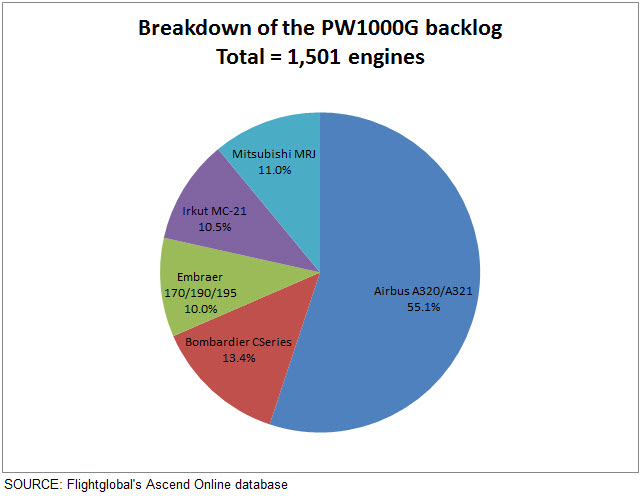Michael Schreyögg has no doubts about the importance to MTU of the Pratt & Whitney PurePower PW1000G geared turbofan. “It is our future,” says Schreyögg, chief programme officer and board member at the Munich-based engine specialist, which has an 18% share in an engine that will be built in its thousands over the next decade – thanks to its position on the Airbus A320neo, as well as other new narrowbody and regional airliners.
The German company developed and manufactures the PW1000G high-speed low-pressure turbine, as well as the forward blisk-based half of the eight-stage, high-pressure compressor. The engine will compete with the CFM International Leap on the A320neo family, as well as exclusively powering the Bombardier CSeries, Embraer’s E2 second-generation E-Jets, the Mitsubishi Regional Jet and export versions of the Irkut MC-21.

Although MTU splits its loyalties between the primes – it is a supplier to General Electric on a range of programmes, and works with Rolls-Royce and Snecma on military engines – its P&W relationship is key. MTU is a 16% participant on the P&W-led International Aero Engines V2500 that powers about half the A320-family aircraft in service; its share increased from 11% when Rolls-Royce left the programme, and will rise to 18% on the V2500’s successor.
Most PW1000G deliveries will be the PW1124G, PW1127G and PW1133G variants for the A320 family. Together with the PW1519G, PW1521G and PW1524G for the CSeries, this “ensures we continue to have a major role in narrowbodies for the next generation”, says Schreyögg. The engine also takes MTU into the GE CF34-dominated regional segment with Embraer and Mitsubishi. “Although we overhaul the CF34, we did not play a role in OE in that market,” he says.
MTU also has a role in the certification process and final assembly of the PW1000G. The first Neo engine to be put through its paces in Munich has been on the test rig since mid-January and will shortly complete 20h of assessments. Versions for the CSeries and MRJ have already been tested over the past two years and a second engine for the Bombardier narrowbody is due to arrive in a few weeks.
In another part of its sprawling Munich complex, MTU is gearing up for assembly of the new engine. As part of its workshare deal with P&W, MTU will complete about a third of all PW1000Gs, the first time the German manufacturer has carried out final assembly in large quantities on a major commercial engine. Although final assembly represents only a small amount of the overall value of an engine, its contribution is symbolic and strategic, says Schreyögg.
“It gives MTU another touch, in terms of being one of the few engine manufacturers in the world engaged in final assembly,” he says. “But it also feeds into maintenance. The experience of an OEM is something you don’t have to learn a second time. That’s the real commercial value of a final assembly line.” In addition, he says, it keeps the partnership with P&W closer. “If we or someone else are late on a module, we will both feel it. It’s a one-company approach,” he says.
While MTU said in November it expects the ramp-up of the PW1000G to feed through to a revenue rise in its new engine business “at a mid-teens percentage figure” in 2014, its aftermarket earnings on older programmes have traditionally been steadiest and most profitable, thanks to increased demand for MRO and spare parts. This is why the V2500 will “be important for another 25 years”, says Schreyögg.
The product – still to power the Embraer KC-390 military transport, and in which the Japanese engine makers also have a share – will not peak in terms of aftermarket revenues until 2025. The average age of V2500s in operation is currently seven years, but by the mid-2020s it will be around 12, he says. Its decline beyond that will depend on fuel price and interest rates, but, by that stage, says Schreyögg, the PW1000G “will be starting to provide solid aftermarket revenues”.
MTU has traditionally maintained “clear walls” between its IAE/P&W links and those with GE for which it contributes to the GEnx and GP7000 among others. “GE is a very broad relationship,” says Schreyögg. “As a tier-one, it is vital to manage both worlds. With P&W, we specialise in compressors and turbines; with GE, it is highly complex casings and parts. In terms of intellectual property, we keep the two very distinct.”
Like most German technology companies, MTU sets store by its investment in industrial machinery. A €65 million ($91 million) blisk production hall opened in April 2013. Although MTU has been manufacturing the titanium components for the Eurofighter Typhoon’s Eurojet EJ200 – and later the Airbus A400M’s Europrop TP400 – for 16 years, blisk output will rise from the current 600 to around 3,500 units a year once the PW1000G comes on stream. Ten more advanced milling machines will join the 10 recently installed.
Another innovation is in digital printing, or additive manufacturing. Although MTU is just dipping its toes in the technology, it has begun to produce small nickel alloy parts for the PW1000G. The company began investing in the process – which involves depositing hundreds of layers of a molten powdery base material – five years ago, and Schreyögg says the challenge is to industrialise a technique beginning to be used by automotive and medical equipment manufacturers.
The benefits, he maintains, span original equipment and MRO. “With OE, you can build new structures without milling machinery. It gives you flexibility and allows you to build lightweight designs,” he says. “In the aftermarket, you can produce parts quicker in response to demand. You don’t need inventories.” He adds: “In five years, will it be a significant part of our production processes? I doubt it. But will it be in 15 years? For sure.”
Source: Flight International























